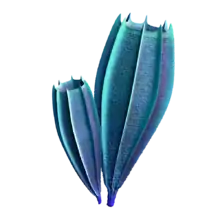Takakkawia
Takakkawia is a genus of sponge in the order Protomonaxonida and the family Takakkawiidae. It is known from the Middle Cambrian Burgess Shale that reached around 4 cm in height.[1] Its structure comprises four columns of multi-rayed, organic spicules (perhaps originally calcareous or siliceous) that align to form flanges.[2] The spicules form blade-like structures, ornamented with concentric rings.[2]
| Takakkawia | |
|---|---|
 | |
| Reconstruction of Takakkawia lineata | |
| Scientific classification | |
| Kingdom: | Animalia |
| Phylum: | Porifera |
| Class: | Demospongiae |
| Order: | †Protomonaxonida |
| Family: | †Takakkawiidae |
| Genus: | †Takakkawia Walcott, 1920 |
| Species | |
| |
It was first described in 1920 by Charles Doolittle Walcott.[3] It was named after the Takakkaw Falls which mark the start of the trail to Fossil Ridge.[4] 1377 specimens of Takakkawia are known from the Greater Phyllopod bed, where they comprise 2.62% of the community.[5]
References
- Botting, J. (November–December 2007). "'Cambrian' demosponges in the Ordovician of Morocco: Insights into the early evolutionary history of sponges". Geobios. 40 (6): 737–748. doi:10.1016/j.geobios.2007.02.006.
- Botting, J. P.; Jin, J. (2012). "Reassessment of the problematic Burgess Shale spongeTakakkawia lineataWalcott, 1920". Canadian Journal of Earth Sciences. 49 (9): 1087. doi:10.1139/e2012-046.
- Walcott, C. D. (1920). "Cambrian geology and paleontology IV:6—Middle Cambrian Spongiae". Smithsonian Miscellaneous Collections. 67: 261–364.
- J.J. Sepkoski, D. Jablonski & M. Foote (2002). "A compendium of fossil marine animal genera". Cite journal requires
|journal=(help) - Caron, Jean-Bernard; Jackson, Donald A. (October 2006). "Taphonomy of the Greater Phyllopod Bed community, Burgess Shale". PALAIOS. 21 (5): 451–65. doi:10.2110/palo.2003.P05-070R. JSTOR 20173022.
External links
- * "Takakkawia lineata". Burgess Shale Fossil Gallery. Virtual Museum of Canada. 2011.
- Image of fossil from the Peabody Museum of Natural History
- Takakkawia at fossilworks
This article is issued from Wikipedia. The text is licensed under Creative Commons - Attribution - Sharealike. Additional terms may apply for the media files.